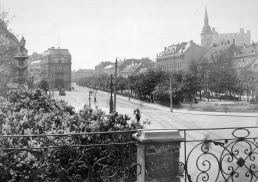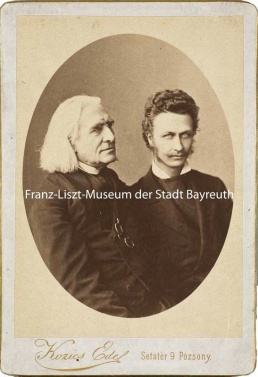Ede Kozics
 | |
| Born |
May 21, 1829 Dubnica nad Váhom, Kingdom of Hungary, Austrian Empire |
|---|---|
| Died |
April 25, 1874 (aged 44) Bratislava, Austria-Hungary |
Ede Kozics (Eduard Nepomuk Kozič) was a 19th-century photographer. His name and life is most closely associated with his famed photo studio in Bratislava (then Pressburg) which had been operated by his family for over seven decades.
Life and work
Ede Kozics was born in 1829 in Dubnica nad Váhom, Kingdom of Hungary (today Slovakia).
As an unsuccessful candidate for study in the seminary he was trained in ribbon-making and used to make silhouette portraits (cut from lightweight black cardboard and mounted on a pale background [6]). In 1847, he first encountered daguerreotype and found his lifelong passion. He received training from traveling photographer Johann Bubenik who also sold him the equipment (Bubenik was making daguerreotypes in Bratislava in 1847 [7]). Soon he also learnt calotype (talbotype) technique and collodion process from Andreas Groll in Vienna, as well as coloring technique.


He opened his first garden studio in Bratislava in 1850 on Kozia street. In 1856 he moved to a more populated location on Promenade 34 (today Hviezdoslavovo námestie) nearby Carlton hotel.[8] After temporary relocation (on 1 June 1868 to the house of Baron Sina on Promenade 33), Kozics studio opened on 1 October 1868 in a newly built house on Promenade 2 (later renamed to Sétatér 9, Kossuth Lajos Platz/Kossuth Lajostér 9, today Hviezdoslavovo námestie 4 [9]), next to the Hotel zum grünen Baum.[10][11][12][13] The house served as home to him and his family and also functioned as a museum, gallery and salon, which was known for its lively social happenings. Kozics hosted several concerts of his close friend Franz Liszt and made a number of his portraits.
Portraits were Kozics specialty, among his clients were Bratislava's most prominent figures. He also photographed city sights and suburbs, from the 1860s particularly in then popular CDV format (cards).
Kozics had significant technical skills. He was fast in adopting cutting-edge photo techniques of his day including calotype (c1850) [14], panotype (c1856) [15], and chromotype (late 1870s) [16]. He developed his own method of color photography; was among the first to make lifesize photographs; invented and patented a way to print photographs on skin, porcelain, canvas, glass and email.
Kozics also ran a private school of photography and was influential for the whole generation of photographers.
He died in 1874 in Bratislava and is buried there at Ondrejský cintorín. Since the 1990s Bratislava has a street named after him.[1]
After his death, the studio continued to be operated by his wife Karolína (born Heller, 1838–1899) who expanded the studio ouvre to postcard production and service for artists. Her specialisation was photomontage. Their kids Karolína Eleonóra Ema Kozicz (1856–?) and Eduard František Xaver Kozicz (2.1.1864–1900) were both photographers and painters, Karolína focused mostly on photo reportage (eg. Požiar Podhradia 1913 series). She operated the family studio until 1926[2] when it was taken over by the firm Boceky and Valentik. Artefacts from the studio are archived in museums in Bratislava and Košice.
Works
- Ede Kozics c1856-1868.jpg
c1856-68.[1]
Abraham von Szontagh, physician and homeopath, 1861.[2]
Maria Theresa statue, Bratislava, 1897. Photo: Kozits studio.[3]
Notes
Literature
- Lipták, Juraj (1973). Eduard Kozič a Karol Divald (MA). Prague: FAMU. pp. 34 (Slovak).
- Pokorný, Boris (1994). "Dokumenty Kozičovho ateliéru". Pamiatky a múzeá (Tatran) 43 (2): 43-44 (Slovak).
- Rumanovská, Pavlína (March-May 2009). "História pomenovaní devínskych ulíc a uličiek". Devínčan 7: 6 (Slovak).

